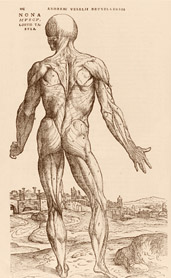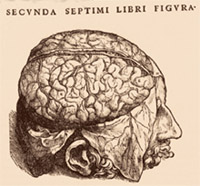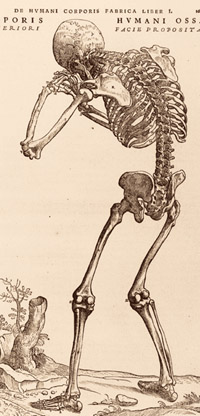Anatomy
of an Anatomy Text
>>Andreas
Vesalius gave Western medicine new views of the human body - and
a landmark book.
 Among
the many early volumes in the University of Chicago Library's
Department of Special Collections is a work that is at once beautiful
and revolutionary.
Among
the many early volumes in the University of Chicago Library's
Department of Special Collections is a work that is at once beautiful
and revolutionary.
First
published in 1543, Andreas Vesalius's study in anatomy De Humani
Corporis Fabrica Libri Septem (which translates to On the
Fabric of the Human Body) was one of the first books to go
into minute detail on the entire human body and provides more
than 200 woodcuts to accompany the text. The work-written primarily
for anatomy teachers-is made up of intricate drawings of the human
muscular and skeletal systems and internal organs, and was Vesalius's
attempt to provide a systematic description of the human anatomy
based on his own findings.
 Vesalius,
who received his medical training in Paris, Louvain, and in the
Italian city of Padua, was a lecturer on anatomy at the University
of Padua. The young physician-he was just 28 when De Fabrica
appeared-compiled much of his information about the body through
the public and private dissections he performed. The public dissections
also served as a learning tool for his students, who came to operating
theaters to see Vesalius at work.
Vesalius,
who received his medical training in Paris, Louvain, and in the
Italian city of Padua, was a lecturer on anatomy at the University
of Padua. The young physician-he was just 28 when De Fabrica
appeared-compiled much of his information about the body through
the public and private dissections he performed. The public dissections
also served as a learning tool for his students, who came to operating
theaters to see Vesalius at work.
Writing
in De Fabrica, he outlines his tools and methods of dissection.
Along with medical instruction, he gives the reader a touch of
intrigue and illegality. Because of the scarcity of bodies for
dissection, he often resorted to grave robbing, which he chronicles
in De Fabrica. Vesalius also used bodies from public executions,
which he requested take place at times more convenient to his
schedule.
 Of
the 500 copies of De Fabrica, about 130 copies survive.
A first edition was acquired by the University in the 1950s and
is part of the Morris Fishbein Collection in the History of Medicine.
(Fishbein, SB'10, MD'12, was a longtime editor of the Journal
of the American Medical Association.) The book resides in
Special Collections along with many other landmarks in the history
of science, including a first edition of Copernicus's De revolutionibus
orbium coelestium, published the same year as De Fabrica.
Despite
its age, De Fabrica is in remarkably fine condition-in
part because both text and illustrations were printed on heavy
rag paper, which does not deteriorate as quickly as wood pulp
paper.
Of
the 500 copies of De Fabrica, about 130 copies survive.
A first edition was acquired by the University in the 1950s and
is part of the Morris Fishbein Collection in the History of Medicine.
(Fishbein, SB'10, MD'12, was a longtime editor of the Journal
of the American Medical Association.) The book resides in
Special Collections along with many other landmarks in the history
of science, including a first edition of Copernicus's De revolutionibus
orbium coelestium, published the same year as De Fabrica.
Despite
its age, De Fabrica is in remarkably fine condition-in
part because both text and illustrations were printed on heavy
rag paper, which does not deteriorate as quickly as wood pulp
paper.
Each
copy of De Fabrica was bound according to the specific
taste of the owner, and the Library's copy retains its original
parchment binding. Although the binding has split and yellowed
with time, it continues to hold the 700-plus folio pages firmly
in place.

![]()
 Among
the many early volumes in the University of Chicago Library's
Department of Special Collections is a work that is at once beautiful
and revolutionary.
Among
the many early volumes in the University of Chicago Library's
Department of Special Collections is a work that is at once beautiful
and revolutionary. Vesalius,
who received his medical training in Paris, Louvain, and in the
Italian city of Padua, was a lecturer on anatomy at the University
of Padua. The young physician-he was just 28 when De Fabrica
appeared-compiled much of his information about the body through
the public and private dissections he performed. The public dissections
also served as a learning tool for his students, who came to operating
theaters to see Vesalius at work.
Vesalius,
who received his medical training in Paris, Louvain, and in the
Italian city of Padua, was a lecturer on anatomy at the University
of Padua. The young physician-he was just 28 when De Fabrica
appeared-compiled much of his information about the body through
the public and private dissections he performed. The public dissections
also served as a learning tool for his students, who came to operating
theaters to see Vesalius at work.  Of
the 500 copies of De Fabrica, about 130 copies survive.
A first edition was acquired by the University in the 1950s and
is part of the Morris Fishbein Collection in the History of Medicine.
(Fishbein, SB'10, MD'12, was a longtime editor of the Journal
of the American Medical Association.) The book resides in
Special Collections along with many other landmarks in the history
of science, including a first edition of Copernicus's De revolutionibus
orbium coelestium, published the same year as De Fabrica.
Despite
its age, De Fabrica is in remarkably fine condition-in
part because both text and illustrations were printed on heavy
rag paper, which does not deteriorate as quickly as wood pulp
paper.
Of
the 500 copies of De Fabrica, about 130 copies survive.
A first edition was acquired by the University in the 1950s and
is part of the Morris Fishbein Collection in the History of Medicine.
(Fishbein, SB'10, MD'12, was a longtime editor of the Journal
of the American Medical Association.) The book resides in
Special Collections along with many other landmarks in the history
of science, including a first edition of Copernicus's De revolutionibus
orbium coelestium, published the same year as De Fabrica.
Despite
its age, De Fabrica is in remarkably fine condition-in
part because both text and illustrations were printed on heavy
rag paper, which does not deteriorate as quickly as wood pulp
paper.